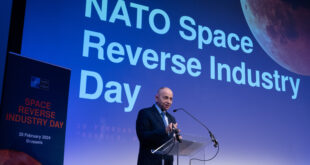
On 6 April 2020, US President Donald J. Trump signed an Executive Order (EO) on Encouraging International Support for the Recovery and Use of Space Resources. This order addresses US policy regarding the recovery and use of resources in outer space, including the Moon and other celestial bodies. Over the next few weeks, SpaceWatch.Global will publish a range of perspectives supporting and opposing the EO from experts around the world. Today’s two expert perspectives come from Professor Steven Freeland of Australia (below) and Professor Dr. Kai-Uwe Schrogl of Germany (see here).
In your opinion, what is the underlying strategic and economic rationale for President Trump’s Executive Order?
The possibility of (commercial) space resource utilisation has once again become a high-profile issue. The United States (2015) and Luxembourg (2017), with more likely others to follow, have enacted national legislation that purports to promote space resource utilisation activities by private entities, whilst still recognising the applicability of the international legal obligations of those countries. The issue of the ‘exploration, exploitation and utilisation of space resources’ has been an agenda item at the Legal Subcommittee of the United Nations Committee on the Peaceful Uses of Outer Space (UN COPUOS) since 2016, and this has already raised a broad range of complicated issues relating to the interpretation of applicable international space law.
These discussions were to continue in earnest during the 2020 UN COPUOS Legal Subcommittee (LSC) meeting, but these were cancelled due to the current COVID-19 situation. Indeed, I understand that the United States had originally intended to release this Executive Order prior to the 2020 LSC meeting, so that the US delegation could then talk to the points made in the Order at those discussions.
American corporations have been at the forefront of proposals to undertake future space resource activities, alongside and complementing the future Artemis / Gateway missions currently being led by NASA. Given the scale of the required investment, these companies need legal assurances and, in 2015, the United States Commercial Space Launch Competitiveness Act, asserted the right of American companies to own and sell resources mined in space “obtained in accordance with applicable law, including the international obligations of the United States”.
This Executive Order appears intended to reiterate the United States’ position on space resource activities, both in terms of informing other countries in direct terms, but also by indicating to its potential space mining industry that the President will support American public and private efforts to utilise space resources.
Given the dramatic economic shift for all economies, including that of the United States, in the wake of necessary Covid-19 financial rescue packages, a supplementary message also flows from the Executive Order, even if it was not intended when the Executive Order was prepared: if space mining technologies are to be developed, and national governments are not in a position to fund all of the necessary research, then the private sector, buoyed with increased confidence about governmental support, will have to step in and put its own money on the table.
The Executive Order explicitly rejects the 1979 Moon Agreement. How do you think this will be received by other countries, particularly other major space powers?
The 1979 Moon Agreement confirms and then expands on several broad principles established in the 1967 Outer Space Treaty. Its principal raison-d’être is the formalisation of the terms of a legal regime that would ultimately apply to the exploitation of the natural resources of the Moon and other celestial bodies. It expressly allows mineral and other space resources to be used for scientific purposes and to support scientific missions, and it introduced a (political) concept for the resources of these celestial bodies – the ‘common heritage of (hu)mankind’. This concept is also used, albeit in a different context and most likely with a different meaning, in the 1982 Law of the Sea Convention with respect the possible exploitation of the natural resources of the deep-sea bed. The Moon Agreement also specified that any such international regime is to be established by its States Parties when such exploitation “is about to become feasible”.
The Moon Agreement was adopted by consensus by UN COPUOS in the late 1970s. However, as is well known, for many geopolitical and other reasons, the Moon Agreement was not ratified by any of the major space-faring countries, including the United States, Russia and China. It currently only has 18 States Parties (by comparison, the Outer Space Treaty has 109). The United States has never adopted the Moon Agreement and has often, within the diplomatic discussions at UN COPUOS, made it clear that it does not regard it as a ‘core’ space treaty.
For the United States, therefore, clarification of its position through this Executive Order involved both a confirmation that space resource mining activities are subject to international law, but that this is centred around the Outer Space Treaty and not the Moon Agreement. From the United States’ perspective, the Outer Space Treaty remains the basis for the necessary multilateral conversations to come.
Whilst some countries, particularly among the current States Parties to the Moon Agreement, might regret the blunt rejection of that treaty by the United States in this Executive Order, no-one will be surprised by the statement on this point. Nor will the rejection of any notion that the Moon Agreement reflects customary international law be a major issue of contention since, to be frank, such an assertion has not been forcefully promoted at an international level. Rather, the idea has really only been mooted by a relatively small group of commentators from time to time. In any event, from a strictly international law perspective, any assertion that the Moon Agreement itself codifies customary international law – except, perhaps, to the extent that it precisely mirrors the terms of the Outer Space Treaty – would be a very difficult argument to sustain.
Given that none of the major space powers are States Parties to the Moon Agreement (although both France and India are Signatory States), I don’t expect that, on this issue at least, there will be much comment by those countries. That is not to say, however, that we will not see strong geopolitical pushback by those countries with respect to other aspects of the Executive Order: indeed, Russia has already given a strong response.
Similarly, the Executive Order explicitly rejects the view that space is a Global Commons. What, in your opinion, is the policy rationale behind this claim and, again, how do you think this will be received by other countries?
The Executive Order confirms that the United States is committed to the Outer Space Treaty, which sets out principles for cooperative exploration and use of outer space that remain as important now as they were back in 1967, if not more so. Thankfully this dispels worrying suggestions in the recent past that the United States might even consider withdrawing from that most fundamental of space law instruments.
Some countries and commentators interpret the terms of the Outer Space Treaty as reflecting that outer space is to be regarded as a ‘global commons’, although this characterisation may have different meanings, depending on one’s perspective. Clearly, through this Executive Order, but also previously, the United States does not accept this classification. Depending on one’s interpretation of that concept, some might argue that a global commons assumes a required sharing of benefits derived from the relevant area, or even shared ‘ownership’ of the area itself. Others might assert, for example, that the concept simply relates to a freedom of access for all to the area. There are also other interpretations that have been raised within this spectrum. Indeed, similar theoretical arguments have been raised in relation to the notion of the ‘common heritage of (hu)mankind’ referred to above.
The United States has viewed any broad interpretation of these concepts with scepticism and its reiteration of a rejection of the ‘global commons’ nomenclature is therefore not surprising.
There will no doubt be some countries that disagree with the United States’ viewpoint on this issue. The classification of space as a global commons is quite regularly pronounced by some delegations at UN COPUOS meetings.
In the end, however, the main issues as to what space ‘is’ and what governance principles apply in practice will, from a legal perspective, depend on the interpretation of the Outer Space Treaty itself.
In your view, how likely will this Executive Order “encourage international support for the public and private recovery and use of resources in outer space…?”
Under the terms of the Executive Order, the Secretary of State is required to report to the President within 180 days (i.e. by early October 2020) as regards “appropriate actions [taken] to encourage international support for the public and private recovery and use of resources in outer space.” These will include the negotiation of “joint statements and bilateral and multilateral arrangements with foreign states.” That report will obviously provide some indications as to the level of international support that the Administration’s policy – as articulated in the Executive Order – has been able to generate, at least in the relatively short-term.
That said, the United States is already engaged in a series of projects which will involve elements related to the issue of resource extraction and is and has been in discussion with other countries to develop partnership arrangements. Whilst it is not possible to be definitive, it is to be assumed that the release of this Executive Order will not alter the trajectory of those discussions. One would have thought that the issues raised in the Executive Order, given that they reflect what largely is already known about the stance of the United States, would have been already been raised in discussions and negotiations taking place before its 6 April release.
It is therefore quite likely that at least some of the actions reported by the Secretary of State later in the year will reflect arrangements that are already well advanced in their planning and proposed implementation.
Whether the release of this Executive Order in and of itself will lead to additional support, over and above the current discussions, remains to be seen. What can be said is that any country now seeking to work with the United States on projects that involve issues related to resource utilisation will be less likely to have doubts about the stance of the United States regarding the matters raised in the Executive Order.
Hypothetically assuming that this Executive Order leads to international support, will it make the prospect of commercial space resource extraction closer to reality?
The fact remains that space is, in many respects, still very ‘hard’ – it is technologically incredibly complex to fulfil any dreams of an off-Earth resources-based economy. Notwithstanding the remarkable progress being made in space-related technology and the limitless ambitions of some of those enterprises seeking to develop space resource extraction capability, we are still a considerable way away from the time that significant space resource utilisation, in ‘commercial’ quantities, will be possible. There are still so many technological challenges to overcome.
Clearly, therefore, to the extent that there is increased international support for these activities, that will allow for a broader degree of expertise, capital, research and capability to be dedicated to this goal. This will tend to push the ‘possible’ more towards the ‘reality’, at least from a technological perspective.
Of course, there are many other challenges and issues that will need to be addressed. The Executive Order has focussed on legal issues, confirming what we already know – that the conduct of any exploration, exploitation and utilisation of space resources will be subject to international law, starting with the Outer Space Treaty.
Yet, as indicated above, there are presently some differing interpretations of the salient terms of that instrument, such that there is not uniform agreement as to the precise scope of the existing relevant international law, let alone what additional ‘rules of the road’ may be required. Difficult questions need to be discussed and debated – and ultimately agreed – at a multilateral level. Whilst this will not be easy, it is essential so that there is a common understanding of the underlying governance framework under which everyone will then be able to operate.
Beyond the legal discussions to come, there are also broad questions around the ethical, cultural, and societal questions that surround any proposed mining of space resources. These will also involve considerations as to who bears the costs of future space exploration, exploitation and utilisation activities and who has the right to profit from it. As is stated in the Outer Space Treaty, for example, space activities are to be “carried out for the benefit and in the interests of all countries”.
In moving forward, we also need to carefully consider how to avoid a ‘tragedy of the commons’ scenario in relation to space resources, just as we must do regarding the challenges associated with increasing space debris. What is really at stake is the future of universal human access to space and the very way we view space.
A clear international understanding must be reached that safeguards the interests of every relevant stakeholder. With careful thought and close cooperation befitting such a significant activity as space resource exploitation, there is a real possibility that the many complexities can ultimately be addressed and resolved. This highlights even further the desirability of multilateral discussions and conversations as to determine how to proceed, and the 6 April Executive Order represents another phase in those ongoing discussions. Without a doubt, it will certainly not be the last.

Steven Freeland is Professor of International Law at Western Sydney University, and also holds Visiting or Adjunct positions at Universities in Vienna, Toulouse, Montreal, Hong Kong, London and Copenhagen. He is a Director of the International Institute of Space Law, and a member of the Space Law Committees of the International Law Association and the International Bar Association. He has advised various Governments around the world on issues related to the national and international regulation of space activities and the development of a national space-industry strategy.





